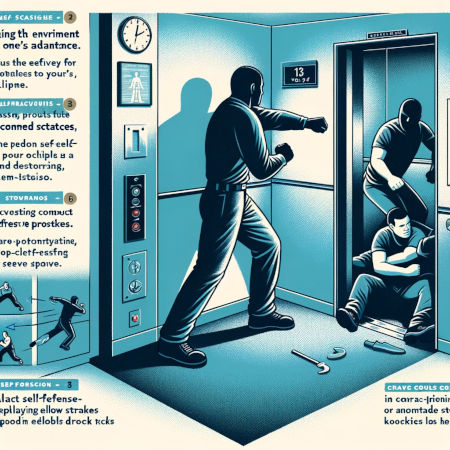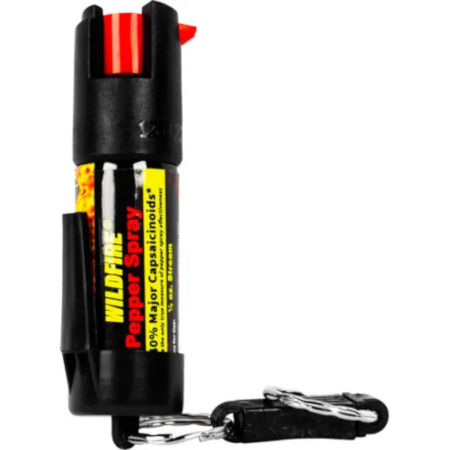Christmas Sale - 10% off. Shop Now!
Self Defense in Confined Spaces

Self-Defense in Confined Spaces: Techniques and Strategies for Maximum Protection
In today's world, personal safety is a paramount concern, especially in confined spaces where your ability to move and react is limited. Whether you're in a crowded elevator, a cramped car, or a narrow hallway, knowing how to defend yourself in these tight quarters is crucial. Confined spaces present unique challenges, but with the right strategies and tools, you can turn these challenges into advantages.
In this guide, we’ll explore effective self-defense strategies tailored for confined spaces, discuss key techniques, and recommend compact self-defense tools to give you the upper hand when space is limited.
Why Confined Spaces Offer Unique Self-Defense Opportunities
At first glance, confined spaces might seem like a disadvantage in a self-defense situation. However, these environments can actually limit an attacker’s ability to maneuver, giving you a potential advantage. In close quarters, large, sweeping gestures and wide strikes are less effective, making it crucial to focus on close-combat techniques and compact self-defense tools.
Key Advantages of Confined Space Self-Defense:
- Restricted Movement: In tight spaces, both you and the attacker have limited movement, reducing the force and effectiveness of their attacks.
- Close Proximity: Close quarters force the attacker to be within arm's reach, making it easier to use grappling techniques and close-range strikes.
- Environmental Leverage: The surrounding environment can be used strategically to your advantage, such as using walls, furniture, or objects as barriers or tools.
Understanding these unique aspects of confined space defense allows you to turn a potential disadvantage into a strategic advantage.
Essential Self-Defense Techniques for Confined Spaces

When it comes to self-defense in confined spaces, it's vital to adapt your techniques to the environment. Here are some essential tactics:
1. Close-Range Strikes and Grappling
In confined spaces, where movement is limited, close-range strikes like elbows, knees, and palm strikes become incredibly effective. These strikes require minimal space to execute and can deliver significant impact, especially when targeting vulnerable areas such as the face, throat, or groin.
- Elbow Strikes: Ideal for tight spaces, elbow strikes are powerful and can be executed with little movement. Use your elbows to strike the attacker's face or ribs.
- Knee Strikes: A quick knee to the attacker’s midsection or groin can incapacitate them long enough for you to escape.
- Palm Strikes: With minimal wind-up needed, a palm strike to the nose or chin can be very effective in close quarters.
Grappling Techniques: When an attacker is within arm’s reach, grappling can be more effective than striking. Techniques like wrist locks, clinch fighting, and leverage-based moves are particularly useful.
- Wrist Locks: By controlling the attacker’s wrist, you can manipulate their movements and neutralize their threat without needing much space.
- Clinch Fighting: This involves grappling while standing, allowing you to control the opponent’s movement and reduce their ability to strike.
Leveraging the Environment for Self-Defense
In any self-defense scenario, especially in a confined space, it's crucial to make the most of your surroundings. This means using every object or spatial arrangement as a tool to help you protect yourself. The immediate environment can be used effectively to impede an aggressor's movement, create obstacles for cover, and engineer opportunities for escape.
1. Using Obstacles for Cover
In a small space, objects like furniture, walls, and other barriers can provide temporary protection or create obstacles that slow down an attacker.
- Furniture as Barriers: If you're in a room, a heavy piece of furniture can be pushed in front of an entry point to block access or slow down the attacker.
- Walls and Corners: Positioning yourself in a corner or against a wall can limit the attacker's options and reduce their ability to attack from multiple angles.
2. Creating Escape Routes
Even in confined spaces, it's crucial to identify potential escape routes. These might include windows, doors, or even small openings that can provide an exit in an emergency.
- Windows and Doors: Knowing the location of windows and doors in any confined space can give you a quick escape option. Consider emergency tools like window breakers that can help you create an exit if needed.
- Visualizing Escape Paths: Mentally rehearse escape routes so that in the heat of the moment, you know exactly where to go and how to get there quickly.
3. Using Improvised Weapons
In a confined space, you may not always have access to traditional self-defense tools. However, everyday objects found in your immediate environment can be transformed into improvised weapons that can help you defend yourself. Recognizing and utilizing these objects can give you an edge when faced with an unexpected threat.
-
Examples of Improvised Weapons:
- Pens and Pencils: A simple pen or pencil can be used as a sharp object to jab at an attacker. Targeting sensitive areas such as the eyes, throat, or hands can incapacitate the assailant long enough for you to escape.
- Keys: Holding your keys between your fingers can turn them into a makeshift weapon. Striking an attacker with your keys can cause significant pain, especially when targeting soft tissue areas like the face or neck.
- Bags and Purses: A heavy purse or bag can be swung at an attacker to create distance or knock them off balance. If your bag contains hard objects, the impact can be even more effective.
- Books or Magazines: A rolled-up magazine or a thick book can be used to strike an attacker or block incoming blows. These items can add weight and force to your strikes.
- Clothing: A scarf or belt can be used to choke or entangle an attacker, giving you control over their movements. Similarly, a jacket can be thrown over their face to disorient them temporarily.
- Household Items: If you're in a kitchen or office, items like a frying pan, heavy mug, or stapler can serve as effective blunt objects to strike or throw at an attacker.
-
Strategic Considerations:
- Quick Access: When faced with a sudden threat, your ability to quickly identify and access improvised weapons is crucial. Train yourself to scan your environment for potential weapons as a precautionary measure.
-
Confidence and Precision: Using improvised weapons effectively requires confidence and precision. Practice handling everyday objects with self-defense in mind so that you can deploy them quickly and effectively if needed. By regularly familiarizing yourself with potential weapons in your environment, you can build the confidence to use them effectively in an emergency.
-
Legal Considerations: While using improvised weapons can be effective in a self-defense situation, it’s essential to understand the legal implications. Always ensure that your actions are justified and proportionate to the threat you’re facing. Knowing the laws in your area about self-defense and the use of everyday objects as weapons can help you navigate these situations with greater confidence and legality.
Compact Self-Defense Tools for Confined Spaces
Having the right tools can make all the difference in a confined space. Compact, easily accessible self-defense tools are particularly effective because they can be deployed quickly and require minimal movement. Here are some essential tools to consider:
1. Keychain Pepper Sprays
Keychain pepper sprays are one of the most convenient and effective self-defense tools for confined spaces. They are small enough to be carried discreetly yet powerful enough to incapacitate an attacker.
- Recommendation: Keychain Pepper Sprays come in various designs and strengths, providing a quick and accessible defense option in tight quarters. They can be attached to your keys or carried in your pocket for easy access.
2. Tactical Pens
A tactical pen is a discreet self-defense tool that can double as a writing instrument. It’s designed to deliver powerful strikes and can be used as a stabbing weapon in close combat.
Tactical Pen - Multipurpose Self Defense Tool
- Recommendation: The Tactical Pen is sturdy, easy to carry, and perfect for delivering strong, precise blows in confined spaces.
3. Compact Stun Guns
Small, discreet stun guns are highly effective in confined spaces. Despite their compact size, they deliver a powerful electric shock that can incapacitate an attacker, giving you time to escape.
- Recommendation: Compact Stun Guns are available in various designs, making them easy to carry in a pocket or bag. They provide a formidable defense option even when space is limited.
4. Personal Alarms
Personal alarms are designed to emit a loud sound when activated, drawing attention and deterring attackers. They are especially useful in confined spaces where shouting for help may not be practical.
- Recommendation: Compact Personal Alarms are small, easy to use, and can be attached to your keys or carried in your pocket. These alarms can be a lifesaver in tight situations where immediate help is needed.
Cultivating a Survival Mindset
In addition to physical techniques and tools, cultivating a survival mindset is critical for self-defense in confined spaces. This involves staying aware of your surroundings, being mentally prepared for potential threats, and maintaining the determination to protect yourself at all costs.
1. Situational Awareness
Always be aware of your surroundings, even in familiar places. Recognize potential threats and identify objects in your environment that could be used for self-defense.
2. Mental Preparation
Prepare yourself mentally by visualizing different scenarios and how you would respond. This mental rehearsal can help you react more quickly and effectively in an actual emergency.
3. Confidence and Determination
Confidence in your ability to defend yourself is crucial. Whether you’re using physical techniques, leveraging your environment, or deploying self-defense tools, your mindset will ultimately determine your effectiveness in a crisis.
Conclusion: Be Prepared for Any Situation

Self-defense in confined spaces requires a combination of physical techniques, environmental awareness, and the right tools. By understanding the unique challenges and opportunities these situations present, you can turn tight quarters to your advantage.
Start by mastering close-combat techniques and making sure you have the right compact self-defense tools on hand. Remember, the best defense is a proactive approach—prepare yourself mentally and physically, and you’ll be ready to protect yourself no matter the circumstances.
For more information on self-defense tools and strategies tailored for confined spaces, or to explore our range of compact self-defense products, visit TBOTECH today. Stay safe and secure, no matter where you are!
Add your comment now!
Post CommentRecent posts
-
12/10/2024How to Protect Yourself with a Self Defense Baton
-
11/19/202410 Essential Apartment Security Tips
-
11/12/2024Self Defense for the Disabled: Strategies and Resources


